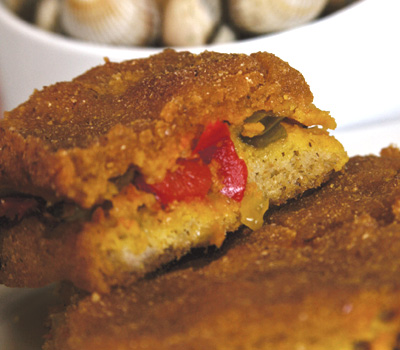You are in the twelfth century. You live in a little town close to, I don’t know, Bremen, and for some reason (probably something evil that you did) you begin a pilgrimage to Santiago de Compostela. Rumor has it that if you worship the relics of the Apostle James, you’ll win yourself a slice of paradise. Of course, it’s the Middle Ages, which means you’ll be traveling the 1,500 miles to Santiago on foot.


No, I didn’t come up with this story myself. A parishioner told it to me at the Bar Trafalgar in Santiago de Compostela as we each drank a glass of mencía with a slice of tuna empanada, all for a euro. The conversation was free, and the truth is, so was the tuna empanada. In any bar in Santiago, you pay for the wine and the tuna empanada is on the house, like a tapa, like somebody putting out a plate of peanuts next to your beer. This is the common Galician custom that goes back centuries, rooted in the culture of the Arabs, the Romans or the Celts—nobody really knows. It’s a routine in every corner bar in Santiago, and nobody really pays much attention. However, the routine of it doesn’t strip away any of the richness or diversity of the Galician empanada.
A Galician empanada is simply dough filled with any of a variety of ingredients: sardines, cockles, pork, eels, chicken and bonito. There are almost no restrictions. It’s baked in a large pan and served in slices—recently made, hot, as the main course, or cold, to calm one’s hunger at midday, in the corner bar.
The filling depends on your whereabouts in Galicia. If you’re close to the sea, it’s seafood. In Rías Baixas, cockles and scallops are the empanadas of choice. Lampreys by the rivers. Zorzas (the pork that goes into sausage) make a bomb of an empanada further inland. Papuxa, the tiny birds that are now almost extinct, were the traditional filling in the famous empanadas of Monforte de Lemos, the capital of Ribeira Sacra.
Then there are the plebian, or shall we say more democratic, fillings—bacalao or tuna, usually canned tuna, sadly the most common ingredient in the empanadas that bars serve, the ones that are free with a glass of alvariño or mencía. There’s nothing special about them, unless the cook has put a little extra care into sautéing the onions and peppers, that, it’s worth saying, are the most faithful companions of every empanada, no matter where it’s from.
Sometimes the fillings are chicken and beef, which spark a childhood memory for some Galicians like, for example, Luis Rodríguez, the owner of Viña de Martín, a winery in Arnoia, a little town of stone houses surrounded by vine-covered mountains in the heart of the Ribeiro DO. Those vines, in the hands of Rodríguez, create some of the best red wines in Galicia. While visiting Rodríguez’ cellar, I’ve eaten some of the most memorable empanadas, including one stuffed with bacalao and raisins.
In my last visit to Viña de Martín, Rodríguez prepared an empanada tasting for me, which included sardine empanadas—a personal favorite. As we tried it, he recited a proverb (the Galicians are well-versed in proverbs): “A sardine o San Xoan; pinga o pan.” (During San Juan, the sardines drip onto bread.) Regrettably, this proverb loses its rhyme and some of its charm in translation. But it does carry a message. San Juan is in June, when the sardines are fat and oily enough to moisten the empanada crust with their juices. But I was visiting Rodríguez in April, and the sardine empanada that he so carefully prepared for me tasted dry and dull. “When I told the fishmonger that they’re for empanadas, I had to beg him to sell me the sardines,” he explains with a shrug. Fortunately, we have his wines.
The crust that the emaciated sardines are incapable of moistening is made up wheat, which is traditional in the interior towns of Galicia. On the coast, in contrast, corn (“millo”) is traditional, whether on its own or mixed with wheat and rye flours. “The difference between the wheat and corn dough is that the corn dough is much more difficult to work with. You almost can’t roll it out because it falls apart. You must be very careful,” Josefa Buceta tells me, the daughter of fishermen and, for 20 years, the chef and owner of O’Bocoi, a restaurant in the charming stone village of Combarro, near Pontevedra. O’Bocoi is one of the Galician temples of empanadas, especially corn-flour empanadas. For 3.50 euros, and with a marvelous view of the Ría de Pontevedra, you can eat a generous (and marvelously juicy) slice of cockle empanada, accompanied by a glass (actually, a cup) of vino del país, which is what they call a dense, powerfully acidic red wine— marked by the area’s cold climate.
“Nobody makes this kind of dough anymore,” Josefa tells me, proud of her art while feeling a bit resigned to it. I’m busy soaking the dough in the cockle juice that’s left on my plate, an elixir of simplicity. Corn dough, seafood, onions and fried peppers. Not much more. And for the moment, I don’t need more than that.
This story was featured in W&S August 2010.
photo by Rosa Couselo
is the author of Descorchados, an annual guide to the wines of South America, and covers Chile for W&S.
This story appears in the print issue of August 2010.
Like what you read? Subscribe today.
















